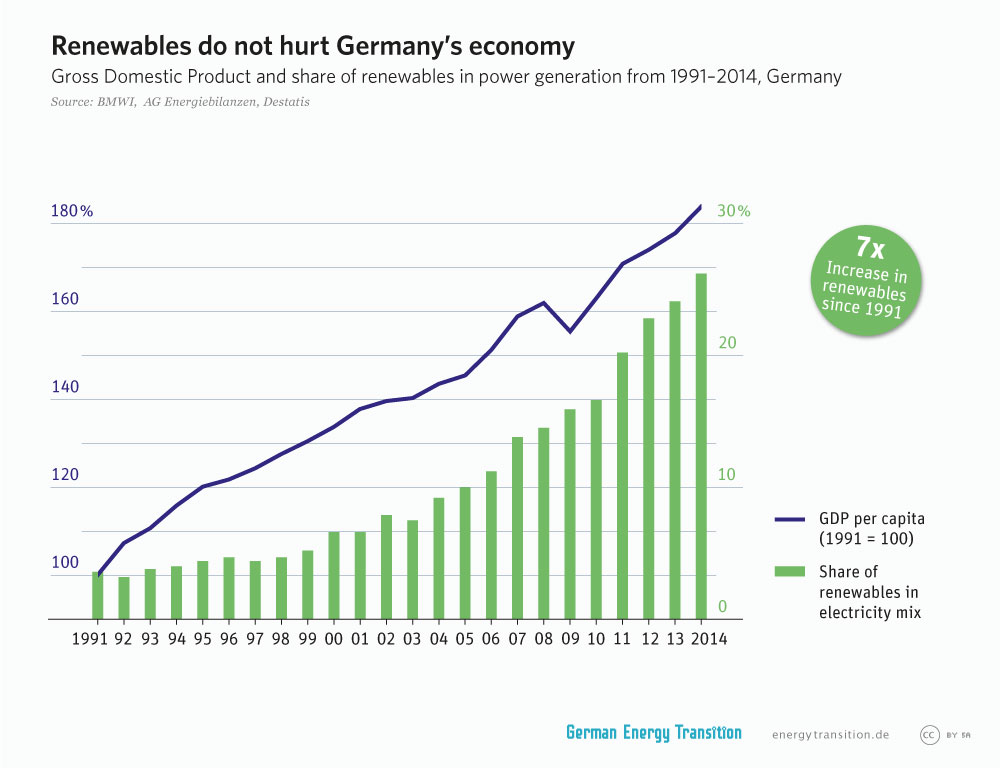The German Energiewende (a brief overview)
Germany has drawn a lot of international attention these past couple of years with regards to its ambitious energy transition, known as the Energiewende. The objective is simple and clear: to cut CO2 emissions by 80% by 2050 (on 1990 levels). Other countries have plans to cut CO2 emissions as well, but Germany seems very determined to reach its target. To do this, Germany plans on cutting its current energy consumption by 50% (on 2008 levels) and increasing renewable energy generation to 80% of the country’s total production (in 2014, renewables represented 27%) . Just to be clear, by “renewable” we are referring mostly to biomass, wind, solar and hydro, not nuclear! The Energiewende took shape out of the anti nuclear protests and oil shocks of the 1970’s. What began as a grassroots movement several decades ago has now turned into a top priority for German politicians.
Germany has been and will remain a leader in the transition to sustainability. The country is not hesitating to take the necessary steps to ensure a cleaner and safer future. In 2011, the decision was made to shut down all 17 of Germany’s nuclear power plants which represented about 23% of the country’s energy production in 2010. Nine have been switched off so far with the remainder to be shut down by 2022. It is true that Germany has increased generation from coal in the past couple of years, but it is important to recognize that this is only a medium term means to an end while the country undergoes its transition. Also, the country is not hesitating to invest €35bn in a high voltage nationwide transmission network in order to accommodate a large uptake of renewable energy. In addition, investment is also being made in smart grids to better match supply and demand for electricity.
Germany was the first European country to implement feed in tariffs as early as 1990. Feed in tariffs guarantee a rate on the electricity sold back to the grid, which allows people with renewable energy systems to payback their investment quicker. Following a nationwide uptake of solar as a result of feed in tariffs, the next logical step is to develop battery storage technology, which eliminates the need for feed in tariffs. This technology is evolving quickly here too. In 2014, 10,000 German homes were equipped with batteries and this market is expected to grow 10x by 2018. But battery storage technology is only one of a series of technologies that the country is developing in its various sustainability focused R&D centres. These R&D centres work closely with governments, businesses and schools to ensure that the technologies’ potential is maximized. One of these centres is called Fraunhofer ISE which is the largest solar energy research institute in Europe.
Above are just a few examples that reflect Germany’s commitment and structured approach to tackling climate change. But the Energiewende is not just about global warming. It is also about having a tangible goal that all citizens can be proud of working towards. In addition, the country is eliminating the threat of nuclear, becoming less reliant on energy imports and developing technologies that put it in a strong position for the digital age.
In the UK, the government is taking measures against sustainable development as it feels these are a strain on its economy. Not everything that counts can be counted and not everything that can be counted counts. It is true that implementing sustainable change on a national level requires some form of subsidy which may be more costly than complacency. Nevertheless, consider what the Energiewende is doing for the German economy. Despite the transition, Germany remains a powerful and industrious nation. Since 1991, German GDP has risen nearly 170% while renewable energy production has increased from 4% to 27%. Jobs in the renewables sector have doubled in the last ten years and surpassed those in the coal mining and conventional fuels sector, which have stagnated. In addition to these positive changes on the economy, the country is on track to cut its CO2 emissions -40% by 2020 (on 1990 levels). 
